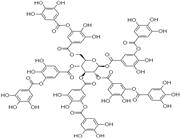Product no. chemwill-TNCAD-9201006
highly quality and immedaite delivery
Tannic acid Manufacturer High quality Best price In stock factory CAS 1401-55-4
Tannic acid 1401-55-4 Gallotannin
Tannic acid CAS 1401-55-4
Gallotannic acid; Gallotannin; Galloylglucose; Glycerite; Quebracho; Tannins CAS 1401-55-4
Name: Tannic acid
Synonyms: TANNIC ACID PWD;Tannic acid Source: Chinese natural gall nuts;Tannic acid tested according to Ph.Eur.;Tannic acid Vetec(TM) reagent grade;Tannic Acid(Pharmaceutical/Tech/Dyes/Food Grade);Tannic acid 1kg;Penta-(n-digalloyl)glucose;TANNIC ACID POWDER, EXTRA PURE, U. S
CAS: 1401-55-4
MF: C76H52O46
MW: 1701.2
EINECS: 215-753-2
Product Categories: Inhibitors;Catechins & Tannins;-;Plant Extract;Food additive and acidulant
Mol File: 1401-55-4.mol
Tannic acid Structure
Tannic acid Chemical Properties
Melting point 218 °C(lit.)
Boiling point 862.78°C (rough estimate)
density 1.2965 (rough estimate)
refractive index 1.7040 (estimate)
FEMA 3042 | TANNIC ACID (QUERCUS SPP.)
Fp 198°C
Tannic acid is a specific commercial form of tannin, a type of polyphenol. Its weak acidity (pKa around 10) is due to the numerous phenol groups in the structure. The chemical formula for commercial tannic acid is often given as C76H52O46, which corresponds with decagalloyl glucose, but in fact it is a mixture of polygalloyl glucoses or polygalloyl quinic acid esters with the number of galloyl moieties per molecule ranging from 2 up to 12 depending on the plant source used to extract the tannic acid. Commercial tannic acid is usually extracted from any of the following plant part: Tara pods (Caesalpinia spinosa), gallnuts from Rhus semialata or Quercus infectoria or Sicilian Sumac leaves (Rhus coriaria).
According to the definitions provided in external references such as international pharmacopoeia, Food Chemicals Codex and FAO-WHO tannic acid monograph only tannins sourced from the above-mentioned plants can be considered as tannic acid. Sometimes extracts from chestnut or oak wood are also described as tannic acid but this is an incorrect use of the term. It is a yellow to light brown amorphous powder; 2850 grams dissolves in one litre of water (1.7 moles per liter).
While tannic acid is a specific type of tannin (plant polyphenol), the two terms are sometimes (incorrectly) used interchangeably. The long-standing misuse of the terms, and its inclusion in scholarly articles has compounded the confusion. This is particularly widespread in relation to green tea and black tea, both of which contain tannin but not tannic acid.
Tannic acid is not an appropriate standard for any type of tannin analysis because of its poorly defined composition.
Chinese tannin; Gallotannic acid; Gallotannin; Galloylglucose; Glycerite; Penta NM digalloyl glucose; Quebracho; Tannins; 1,3,6-tris-O-(3,4,5-trihydroxybenzoyl)hexopyranose; 1,2,3,4,6-pentakis-O-[(3,4-dihydroxy-5-{[(3,4,5-trihydroxyphenyl)carbonyl]oxy}phenyl)carbonyl]hexopyranose
CAS RN.:
1401-55-4
EINECS: 215-753-2
Appearance & Physical State light yellow to tan solid with a faint odor
Density 2.12 g/cm3
Melting Point 218 °C (dec.)
Flash Point 198ºC
Refractive Index 1.927
Water Solubility 250 g/L (20 ºC)
Stability Stable. Incompatible with metallic salts, strong oxidizing agents, iron and other heavy metals.
Storage Condition Store in a cool, dry, well-ventilated area away from incompatible substances. Keep containers tightly closed. Store protected from light.
Safety Info
RTECS WW5075000
Safety Statements S24/25; S36; S26; S36/37/39; S22
HS Code 3201909000
storage temp. Storage temperature: no restrictions.
solubility ethanol: soluble100mg/mL, yellow to brown
form Powder/Solid
color Yellow to light brown
PH 3.5 (100g/l, H2O, 20°C)
Water Solubility 250 g/L (20 ºC)
Sensitive Air & Light Sensitive
Merck 14,9052
BRN 8186396
Stability: Stable. Incompatible with metallic salts, strong oxidizing agents, iron and other heavy metals.
InChIKey LRBQNJMCXXYXIU-PPKXGCFTSA-N
EPA Substance Registry System Tannins(1401-55-4)
Safety Information
Hazard Codes Xi,Xn
Risk Statements 40-62-63-68-36/37/38-52/53
Safety Statements 24/25-36-26-36/37/39-22-61
WGK Germany 2
RTECS WW5075000
Autoignition Temperature 980 °F
TSCA Yes
HS Code 32019090
Hazardous Substances Data 1401-55-4(Hazardous Substances Data)
MSDS Information
Tannic acid Usage And Synthesis
Physical and Chemical Properties Tannic acid has its structure still remain unclear, and is generally considered to be the ester formed by the five hydroxyl groups of glucose and gallic acid acyl group. The industrial tannic aicd can be obtained by the extraction of Gallic and further concentration. After further purification, we can obtain pharmaceutical or reagent tannic acid.
Tannic acid is a pale yellow amorphous powder or shiny scaly-like or sponge-like solid.
It is suitable for tanning harness leather, sole leather and sheepskin. It is recommended to store it in a cool, dry, ventilated warehouse. It is better to be used in combination with other tanning agents.
Tannic acid Preparation Products And Raw materials
Preparation Products DOWEX(R) 1X8-->Gallic acid-->3,4,5-Trimethoxybenzaldehyde-->CHILLIORANGE-->Propyl gallate-->Methyl 3,4,5-trimethoxybenzoate-->D-glucose pentakis[3,4-dihydroxy-5-[(trihydroxy-3,4,5-benzoyl)oxy]benzoate] -->synthetic tanning agent No.28-->TANNASE-->synthetic tanning agent DLT-10-->Acorn shell btown-->tannalbin-->SODIUM TANNATE-->long-acting vasopressinl-->Gallic acid trimethyl ether-->Sulfonated sodium tannin-->tremella polysaccharide
Raw materials Sodium bisulfite-->Naphthalene-->formaldehyde


 China
China

